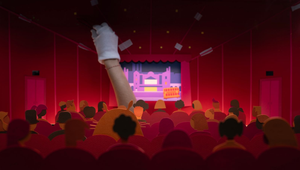
Why Picturesmith Wants to Open Our Eyes to the Possibilities of Animation

Between the Oscar-winning Spider-verse movies and R-rated meme machine Rick and Morty, animation has never been so mainstream. The old myth that it is for children has been thoroughly debunked. And in the advertising space, clients and creatives are embracing animation for everything from TV commercials to social media campaigns and explainer videos.
But animation is an expansive field, and creatives looking to incorporate it into their work can find themselves confused about the best path to take, and how their stylistic choices might reshape the whole production pipeline.
That’s why UK animation studio Picturesmith has created a new guide specifically to help creatives parse out the how and why of different animation techniques and styles. ‘Visual Techniques for Animation’ is a white paper that takes the reader through a range of approaches to animation, outlining the challenges and benefits of each, as well as suggesting the kind of content and tones that are particularly suited to that style.
“We tried to put ourselves in the minds of a creative at an advertising agency, thinking what would be useful to people,” explains Christian Hopkins, creative director at Picturesmith. “Animation is such a broad term - to some people it’s cartoons, to some people it’s a corporate explainer video, to others it’s a whiteboard animation. It can be so many different things. We wanted to help creatives understand some of the different techniques, where it might be useful things to consider.”
The white paper takes readers through techniques like stop motion, replacement animation, 2D animation and more. There’s also helpful vocabulary for non-experts. For example, there’s ‘pixilation’ - not to be confused with pixelation - which in fact refers to the practice of doing stop motion animation but with real human actors.
“I think generally, the more vocabulary and understanding people have on certain subjects, the easier it is to have those conversations,” says Christian. As an example he points to the word ‘boiling’, which in animation terms has nothing to do with water, but could be a really handy concept for creatives. “Boiling is an aesthetic that is really pronounced in a cartoon from the ‘70s called Roobarb and Custard. Loose lines, with a nice wobbly look to it and it’s really beautiful but sometimes you might not want that on a commercial. You might want it to look really slick and smooth. It’s about understanding when you want something and when you don’t want something.”
But the white paper isn’t just about aesthetic choices - it also details the ways that different animation techniques change timings, impact budgets and shape the order in which decisions are made.
Stop motion, in particular, requires more decisions up front. When it can take a whole day to animate a 10-second shot, there’s no space for second takes and the edit has to essentially be nailed down before production begins.
“So much content is editable now with CG animation but when a stop motion project comes along we need to make it clear that not only is it not editable, you shoot the edits, effectively,” says Christian. In order to help clients and creatives make those decision, the team will create test animations to confirm the look of the film and may create a CG pre-visualisation of the shots and edit, so by the time they get to production the team knows exactly what they’re animating and the creatives know what they’re going to end up with.
Christian advises that when agency teams identify that they would like to use animation for a project that they identify the studio they’d like to work with and bring them in as early as possible. That they can help identify the best techniques for the script and, for particularly challenging shots they have time to figure out how to approach them.
There are also a few surprises within the white paper - for example puppetry is often overlooked as an animation style. Christian says that there are times when creatives may approach Picturesmith with a script they want to bring to life with stop motion, but the spontaneity and playfulness they’re looking for would be much better suited to puppetry.
“It’s just really fun. There should be more puppetry scripts out there because it always brings a smile whenever you do it. We’ve done a couple of puppetry jobs - you can make some silly films but they’re also really engaging,” says Sesame Street fan Christian.
In fact, adds Christian, it’s likely that often creatives don’t really know what’s really available, and he hopes the white paper will help open minds. “I think sometimes creatives might need to think outside of the box, they might not know they need animation but when they start looking into it, animation is not one thing,” he says. “And you can really achieve stuff through animation that you just can’t achieve with live action. I guess it’s opening up and being creative about the different techniques that are available.”
If you’d like to read ‘Visual Techniques for Animation: A Guide for Creatives’ please contact Christian at christian[at]picturesmith.com or contact Picturesmith to arrange a chat here













